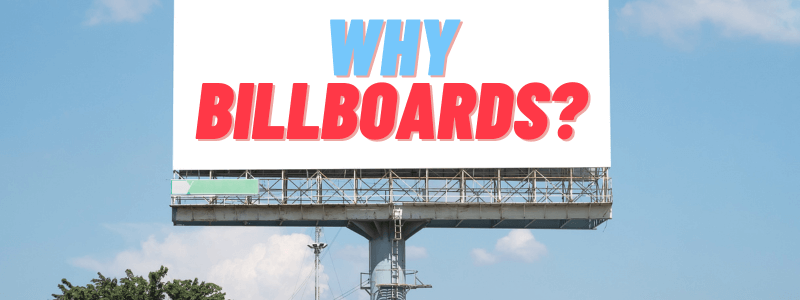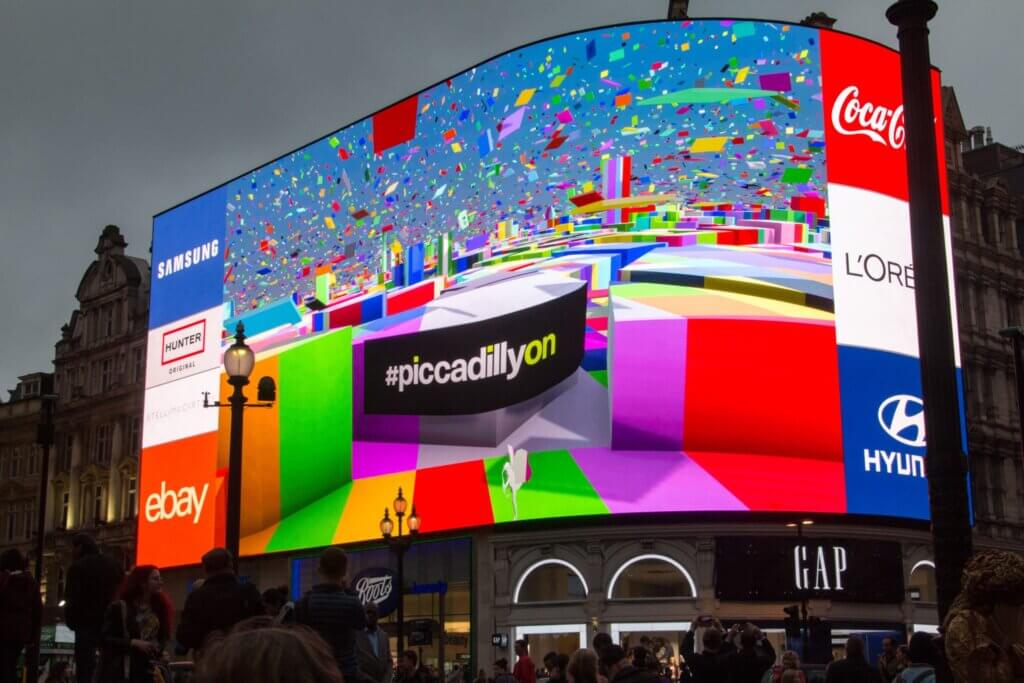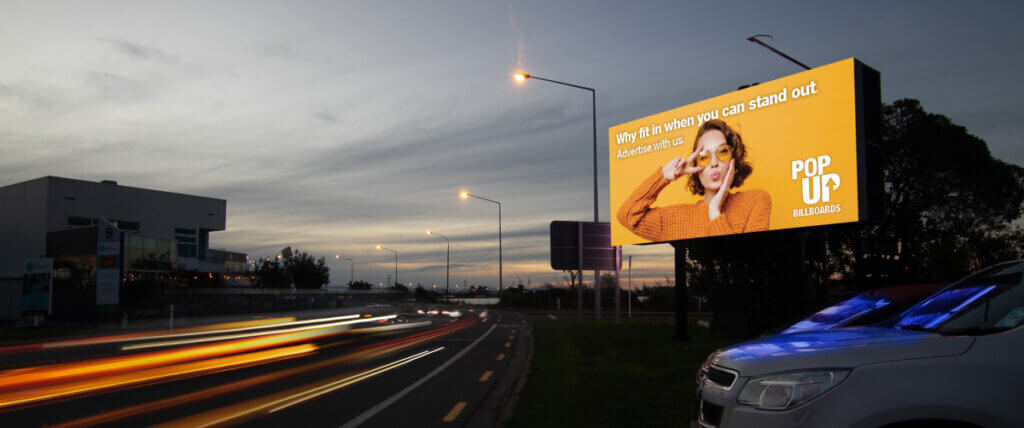In today’s fast-paced world, visibility and the establishment of real connections with consumers are paramount. In the noisy digital crowd and traditional outdoor digital world, some may think traditional advertising doesn’t cut it anymore. But surprise! Outdoor advertising is still a big deal. While everyone’s busy online, old-school billboards and signs are quietly working wonders for brands. They’re not just standing their ground; they’re thriving in grabbing attention and making a lasting impact.
Despite the digital frenzy, outdoor advertising has a unique power. It stands out, boosts brand ads become a secret weapon, giving businesses an edge that’s hard to ignore.
Step into the world of outdoor advertising as we explore the ongoing showdown between two big players: static and digital billboards. In this journey, we’ll break down what each of them is good at, where they might fall short, and what makes them special. Join us as we shine a light on the long-standing discussion in the always-changing world of visual marketing. Get ready for a ride through the heart of static versus digital billboards, where old-school meets tech, and each has its own story to share. It’s a simple yet fascinating trip into the world where traditional and modern advertising collide.
The Evolution of Outdoor Advertising: From Traditional to Digital Billboards
Outdoor Advertisng has roots dating back to ancient civilizations, evolving into iconic billboards in the 19th century. Static billboards became synonymous with mid-20th century advertising, characterized by eye-catching visuals and memorable copy.
Digital Era Emergence:
The late 20th century saw the rise of digital billboards, introducing dynamic content with rotating advertisements. Over time, LED technology advancements enabled high-resolution displays capable of showcasing vibrant images and videos.
Design and Content Trends:
Static billboards excel in visually striking images and concise messaging, while digital billboards offer flexibility with dynamic content changes. Both adapt to technological advancements, with static billboards benefiting from improved printing techniques, and digital billboards evolving with advanced LED technology.
Impact on Brand Communication:
Throughout history, static and digital billboards have played vital roles in brand communication. Static billboards create lasting impressions with timeless charm, while digital billboards cater to the fast-paced nature of contemporary advertising, providing versatile ways to connect with audiences.
The historical progression of outdoor advertising highlights the dynamic interaction between static and digital billboards, each playing a role in shaping the evolving narrative of visual marketing. Transitioning from the timeless allure of static billboards to the dynamic potentials of digital displays, their harmonious coexistence has significantly enhanced the outdoor advertising scene throughout the years.

Purpose of Billboards

Billboards, longstanding titans in the advertising realm, serve as dynamic canvases fostering profound connections between brands and audiences. Their purpose extends beyond mere promotion, encompassing:
- Unmatched Visibility: Amid digital noise, billboards provide a commanding physical presence, ensuring your message stands tall and garners attention for lasting brand awareness.
- Precision Targeting: Diverse formats enable precise localization and demographic targeting, tailoring messages to resonate with specific audiences in different locales.
- Innovative Digital Displays: Evolving with technology, digital billboards bring vibrancy and dynamic content, ensuring your brand remains visually compelling and adaptable.
In essence, billboards transcend traditional advertising, leaving an enduring impression through visibility, targeted strategies, and digital innovation.
Static vs. Digital Billboards
Static billboards, as outdoor advertising mainstays, captivate with their timeless simplicity. With a steadfast design that persists throughout the campaign, these billboards provide a reliable canvas for advertisers. Crafted from durable materials like vinyl, they become iconic landmarks, offering a sense of permanence and brand consistency. Notably, their manual updating process adds a layer of meticulous planning, though lacking the immediacy of digital billboards. In essence, static billboards rely on enduring visuals for a lasting impact, complementing the dynamic options in the digital realm.
On the other hand, Digital billboards revolutionize outdoor advertising by leveraging electronic displays with LED technology, enabling dynamic presentations through a captivating slideshow format. This innovation offers unparalleled flexibility and creativity, incorporating features like animation, video playback, and real-time updates. Advertisers can convey diverse messages within a single billboard space, adapting content swiftly to reflect current events or promotions. In essence, digital billboards redefine outdoor advertising by seamlessly blending technology and creativity, providing a responsive and engaging platform for contemporary marketing strategies.
Design and Visual Appeal of Billboards
Two primary categories of billboards exist: static billboards, often referred to as traditional billboards, and digital billboards. The query arises: which one suits your business best?
Static Billboards:
Tradition meets endurance with static billboards, having served businesses for well over a century in creating enduring brand awareness. Found along highways and bustling intersections, their simplicity and timeless design capture attention. The steadfast nature allows messages to linger for weeks, but exposure to the elements may, over time, dim their visual impact.
Advantages of Static Billboards:
- Persistent Presence: Static billboards maintain a 24/7 presence, consistently delivering messages to the commuting audience.
- Exclusive Showcase: Advertisers enjoy sole occupancy, free from the clutter of competing brands during display.
- Cost Predictability: With printing costs incurred only when crafting a new ad, expenses follow a predictable structure.
Downsides of Static Billboards:
- Fading and Wear: Over time, static ads may fade or wear, diminishing their visual allure.
- Inflexibility: Altering static ads incurs additional costs and faces lead time constraints, limiting adaptability.
- Ad Fatigue: Remaining unchanged for extended periods, static billboards may result in audience disinterest and fatigue.
Digital Billboards:
Step into the future with digital billboards, the electronic maestros transforming the advertising game. Offering dynamic displays, they redefine flexibility, enabling advertisers to tweak messages instantly and adapt campaigns on the fly. Through programmatic DOOH and location data, these billboards become data wizards, providing insights into audience demographics and behavior. The visual experience is elevated with high-definition video and animation, immune to the wear and tear of their static counterparts.
Advantages of Digital Billboards:
- Flexibility and Instant Updates: Digital billboards empower advertisers with real-time adaptability, allowing instant updates.
- Insights through Data: Utilizing location data, advertisers gain profound insights into audience demographics and campaign effectiveness.
- Reactive Advertising: Digital billboards respond to external factors like weather, traffic, and live events, ensuring contextual relevance.
- Visual Appeal: Dynamic creative, featuring video and animation, provides a visually engaging experience, resistant to wear and tear.
Static billboards, with their enduring presence and exclusive showcase, meet the challenge of weathering and inflexibility. In contrast, digital billboards dazzle with their adaptability, real-time updates, data-driven insights, and visually captivating content. Choosing between static and digital billboards hinges on campaign objectives, the desire for flexibility, and the need for dynamic, visually striking content.
Cost Consideration
With a comprehensive understanding of the design dynamics and potential considerations of static and digital billboards. Understanding the financial landscape is pivotal when deciding between static and digital billboards. Let’s shift our focus to a critical aspect of advertising strategy – cost considerations.
Initial Setup Costs:
Static Billboards:
- Lower Initial Costs: Installation of static billboards is more budget-friendly due to the simplicity of design and materials.
- Strategic Resource Allocation: Advertisers can strategically allocate resources for impactful campaigns without extensive upfront investment.
Digital Billboards:
- Higher Initial Costs: Digital billboards come with substantial initial setup costs due to advanced technology, infrastructure, and electronic displays.
- Justifiable Expenditure: Despite higher costs, dynamic capabilities and potential returns may justify the initial investment for businesses seeking versatile and eye-catching advertising solutions.
Maintenance Expenses:
Static Billboards:
- Lower Ongoing Costs: Static billboards generally incur lower maintenance expenses once erected.
- Occasional Maintenance: Regular checks for wear and tear, weather-related damage, and occasional cleaning contribute to manageable maintenance budgets.
Digital Billboards:
- Intensive Maintenance: Digital billboards demand more intensive maintenance due to electronic components, including LED displays and software systems.
- Technical Monitoring: Regular monitoring and potential updates are required, with technical issues needing prompt attention to ensure continuous functionality.
Potential Long-Term Savings:
Static Billboards:
- Cost Savings: Over the long term, static billboards offer cost savings due to maintenance and operational simplicity.
- Stable Financial Landscape: With fewer components and lower ongoing expenses, businesses can enjoy a stable and predictable financial outlook.
Digital Billboards:
- Adaptability for Savings: Despite higher initial and maintenance costs, digital billboards may offer long-term savings through adaptability.
- Efficiency and Optimization: The ability to optimize campaigns, respond to market trends, and gather real-time data can contribute to increased efficiency and savings over time.
Case Studies of Successful Digital Billboard Campaigns:
Having delved into the intricacies of cost considerations between static and digital billboards, let’s shift our focus to the real-world impact of digital billboards through notable case studies. These success stories shed light on the tangible benefits and outcomes that can be achieved by businesses harnessing the dynamic capabilities of digital advertising.
Share a Coke Campaign by Coca-Cola:
Coca-Cola’s “Share a Coke” campaign stands as a testament to the transformative power of digital billboards. The company ingeniously utilized this dynamic platform to display personalized messages, allowing consumers to see their names or customized messages on the larger-than-life screen. This not only sparked buzz and social media engagement but also translated into tangible results with increased sales and enhanced brand loyalty. The case of Coca-Cola exemplifies how personalization on digital billboards can create a profound connection with consumers, fostering a sense of individuality and shared experiences.

McDonald’s Limited-Time Offers Promotion:
McDonald’s, a global fast-food giant, strategically employed digital billboards to promote their limited-time offers. By featuring mouth-watering images of their latest menu items and regularly updating content, McDonald’s effectively utilized the dynamic nature of digital billboards. The result was a surge in foot traffic to their stores, driven by the sense of urgency instilled in consumers. This case study highlights the versatility of digital billboards in creating immediate impact, driving sales, and maintaining brand relevance in the fast-paced world of quick-service restaurants.

Driving Brand Recall through Engaging Outdoor Advertising
Outdoor advertising serves as a cornerstone in brand building, providing unparalleled mass exposure through billboards, transit ads, and posters. Leveraging visuals for better recall, it creates lasting impressions and emotional connections. Tailoring messages to specific locations enhances effectiveness, while the consistency of outdoor presence builds trust. Integrating with digital strategies through QR codes and hashtags ensures a seamless offline-to-online transition. The canvas of outdoor advertising allows for enhanced creativity, reinforcing a brand’s commitment to staying relevant and dynamic. In a digital era, outdoor advertising remains a potent force for brand establishment and reinforcement.
The potential of digital billboards

For investors, grasping the profit potential of digital billboards is paramount for making well-informed decisions. This comprehensive analysis delves into the current market landscape, providing insights into both opportunities and risks associated with investing in this cutting-edge advertising medium.
1. Strategic Location:
The success of a digital billboard hinges on its strategic placement. Optimal locations, such as high-traffic areas like major highways, city centers, and popular tourist destinations, offer heightened visibility to potential advertisers. Selecting areas with promising growth potential and a consistent flow of traffic is instrumental for a lucrative investment.
2. Targeted Marketing:
Understanding the intricacies of your target market is pivotal for attracting advertisers. Digital billboards excel in delivering targeted messages based on demographics, interests, and location. In-depth research into the local market allows the identification of industries poised to benefit from outdoor advertising, enabling a tailored and enticing offering.
3. Technological Advancements:
Staying abreast of the latest technological enhancements in digital billboard displays is imperative. Features like high-resolution screens, real-time data integration, and interactive capabilities enhance the advertising experience, attracting a broader array of advertisers and elevating revenue potential. Future-proofing your investment involves selecting a display system adaptable to emerging trends.
4. Compliance with Regulations:
Before delving into digital billboard investment, a thorough understanding of local regulations and permitting requirements is essential. Variations in zoning laws, sign placement restrictions, and content regulations between jurisdictions underscore the importance of compliance. Adhering to these rules not only averts legal issues but also maximizes the profitability of the investment.
5. Maintenance and Operational Considerations:
Digital billboards necessitate ongoing maintenance and operational costs. Factors such as power consumption, climate resistance, and remote management capabilities play a crucial role in display provider selection. Rigorous maintenance ensures uninterrupted service, fostering client satisfaction and sustained profitability.
6. Return on Investment (ROI) Evaluation:
An in-depth assessment of the potential return on investment is fundamental. Factors such as advertising rates, the volume of advertisers, operational costs, and initial investment all contribute to the overall profitability.
The power of static billboards and traditional OOH advertising

In today’s digitally focused environment, static out-of-home (OOH) billboards continue to hold sway, affording advertisers a distinct advantage through their enduring visibility, attention-grabbing formats, and strategically positioned displays amidst the overwhelming saturation of digital content. The persistence of static billboards as a potent and effective advertising medium in the contemporary digital age prompts an exploration of their enduring appeal and impact.
Visual Impact and Enduring Exposure:
Static billboards, with their large formats and eye-catching visuals, have the innate ability to cut through the digital clutter, leaving a lasting impact on viewers. The sheer size and striking designs of static billboards command attention, ensuring that the message stands out amidst the fast-paced, digital-saturated environment.
Strategic Placement for Maximum Visibility:
The strategic placement of static billboards plays a pivotal role in their effectiveness. By situating these billboards in high-traffic areas, such as major highways, city centers, and popular tourist destinations, advertisers can capitalize on maximum visibility. Unlike the transient nature of digital billboards, static billboards offer enduring exposure, allowing brands to cast a wide net and achieve brand awareness objectives consistently.
Custom Creative Experiences:
Static billboards provide a canvas for custom creative experiences that leverage unique, eye-catching designs. Unlike their digital counterparts, static billboards offer the opportunity for 3D extensions, embellishments, and bespoke installations. Creative executions, such as the Cadbury campaign with 3D chocolate bars or Corona’s foliage-adorned billboard, showcase the potential to go beyond flat dimensions and create immersive, memorable experiences.
Localized Targeting and Tailored Content:
Static billboards excel at reaching specific local audiences effectively. Through precise localization, advertisers can strategically place billboards to engage local audiences with relevant content. This localization strategy not only enhances the connection with the community but also provides a cost-effective means for local businesses to connect with nearby consumers on a more personal level.
While lacking the dynamic features of digital billboards, static billboards leverage their visual impact, strategic placement, custom creative experiences, and localized targeting to capture attention effectively. By integrating these elements into modern advertising strategies, marketers can unlock the enduring power and impact of static billboards, complementing digital campaigns and resonating with target audiences in a unique and memorable way.
Technological Advancements
Our journey through the landscape of outdoor advertising now takes an exciting turn into the realm of innovation. In this section, we’ll explore the technological frontiers that are reshaping digital billboards. From the immersive experiences of augmented reality to the adaptive nature of responsive ads and the precision of geotargeting, these advancements redefine how brands captivate audiences on the expansive canvas of outdoor advertising. Join us as we unveil the cutting-edge technologies propelling billboards into a new era of engagement and impact.

Augmented Reality (AR) Integration:
One of the groundbreaking advancements is the seamless integration of Augmented Reality (AR) into digital billboards. This innovation transcends traditional static images, offering an immersive and interactive experience for viewers. AR technology enables billboards to interact with the physical world, allowing consumers to engage with the content in real-time. This not only enhances the visual appeal but also creates memorable experiences that resonate with the audience, bringing a new dimension to outdoor advertising.
Responsive Ads:
The era of static, unchanging billboards is evolving into a dynamic showcase of responsive ads. Digital billboards can now adapt their content based on real-time data, such as weather conditions, time of day, or even the demographics of the audience. This responsiveness ensures that the content remains relevant and engaging, maximizing the impact of the advertising message.
Geotargeting:
Geotargeting has emerged as a powerful tool in the arsenal of digital billboard technology. This innovation allows advertisers to deliver highly targeted content based on the location of the billboard and the movement of the audience. By leveraging location data, advertisers can create campaigns that resonate specifically with the local audience, increasing relevance and engagement. Geotargeting not only enhances the efficiency of advertising but also opens new possibilities for localized promotions and community engagement.
Contributions to Outdoor Advertising:
These technological advancements collectively contribute to the dynamic evolution of outdoor advertising. The integration of AR elevates the level of engagement, responsive ads ensure contextual relevance, and geotargeting enables personalized communication. The result is a more tailored, interactive, and impactful advertising experience for both advertisers and consumers. As technological innovations continue to unfold, digital billboards are poised to remain at the forefront of the ever-changing landscape of outdoor advertising, providing new avenues for creativity and audience connection.
In conclusion, this guide reinforces the enduring impact of static billboards in the advertising landscape. By showcasing their visual allure, strategic positioning, and creative flexibility, the guide emphasizes the lasting power of these traditional displays. Additionally, it underscores the importance of integrating static billboards with digital strategies, creating a synergistic and potent approach to outdoor advertising. As a concise roadmap, this user guide is a valuable resource for businesses seeking to navigate the dynamic terrain of billboard advertising effectively, ensuring a holistic and impactful marketing strategy.


